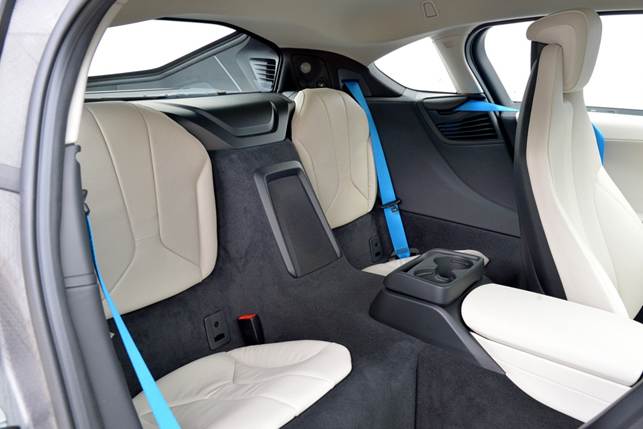Onto some canyon roads, I pulled the gear
lever left into Sport mode, pushed the throttle a little further, and the car
responded. It doesn’t so much accelerate as place itself farther down the road.
However often I drive cars with electric motors, I’m always a little stunned
the first time the torque deploys. It’s just so effective.
I climbed away from the coast, the little
three-cylinder booming into the cabin with the help of acoustic witchcraft. It
really wants to rev, zinging easily beyond 4,000 rpm. If you use the paddles,
the transmission holds gears beyond 6,000. But above all, it’s the relationship
between the electric torque and the gasoline power that defines the experience.
There’s significant torque-fill at low rpm, with the motors stepping in to help
out while the turbo spools, and this catapults the car out of slow turns so
well that a Subaru STI was repeatedly left wheezing behind me. In terms of
cross-country pace, the i8 is massively fast.

The
i8's rear seats grant it a modicum of practicality
If the engineers were tasked with
fashioning an analog driving experience from various digital components,
they’ve done a fine job. But it’s clear they also let their imaginations run a
little - as well they should have, given this car’s potentially pivotal role in
the story of the sports car-to introduce some new characteristics.
I’ve already mentioned the first:
unfettered speed. In Sport mode, the i8’s combination of torque, traction, and
agility are astounding. At one point during this test, an interested observer
asked me what it was like to drive. My instinctive response was “fast.” That’s
telling-we drive a lot of quick things in this line of work, and very few of
them leave you gibbering about speed.
The other main point of celebration is the
relationship between grunt and right-foot action. You’ll need to hear me out
here, because this is where the i8 becomes complicated. It doesn’t take long to
realize that, for people like you and me, managing the arrival of torque is the
i8’s hub. Leave the transmission in automatic, and the six-speed does a decent
job juggling those different power sources, occasionally performing a slow
downshift but mostly blipping the perfect blip and leaving the driver time to
find the line.

The
scissor-type doors that open forward and upward in wing-like fashion, add extra
intrigue to the design
Switch to paddle shifts, though, and you
can play more. For starters, whatever gear your head tells you is optimal
because of the tachometer reading, try one higher, and you’ll almost certainly
go faster. It’s freakish. Initially, you think second-gear hairpins are just
that. But then you try third, the dash indicator impishly flashes “Boost,” and
electricity takes hold. Third is the new second. (Repeat, ad infinitum.)
If electricity’s influence in such
conditions is unquestionably positive, the benefits are less clear in faster,
more open turns. I found myself anticipating apexes, much like you would in an
old-school turbo car, because at higher speed, there’s less power available up
front to mask the combustion engine’s inherently slower response. And because
the electric boost is delivered through the front axle, the continually varying
ratio of front (electron) torque to rear (engine) grunt means chassis behavior
also varies continually.

Like
the headlights, the intricately designed rear light clusters also feature the
characteristic BMW i U-shaped design
When torque arrives up front, the car
becomes four-wheel drive and the chassis goes neutral. Switch traction control
off (which you should, because it’s a little intrusive) and the rear axle will
initially make pleasing suggestions. But use the electric torque, and the car
just bolts forward, neutral, like a Nissan GT-R.
Of course, the opposite is true if you stay
in a lower gear - where there’s more fossil power available to the rear
wheels-and avoid using the electric boost. Then you can rev the little motor
higher, enjoy the sound, and relish the fact that the car feels more rear-drive,
because it is. This is a machine whose chassis behavior varies according to the
driver’s gear selection and torque demands. It remains to be seen if BMW wanted
the car to feel like that, but it sure makes things interesting.